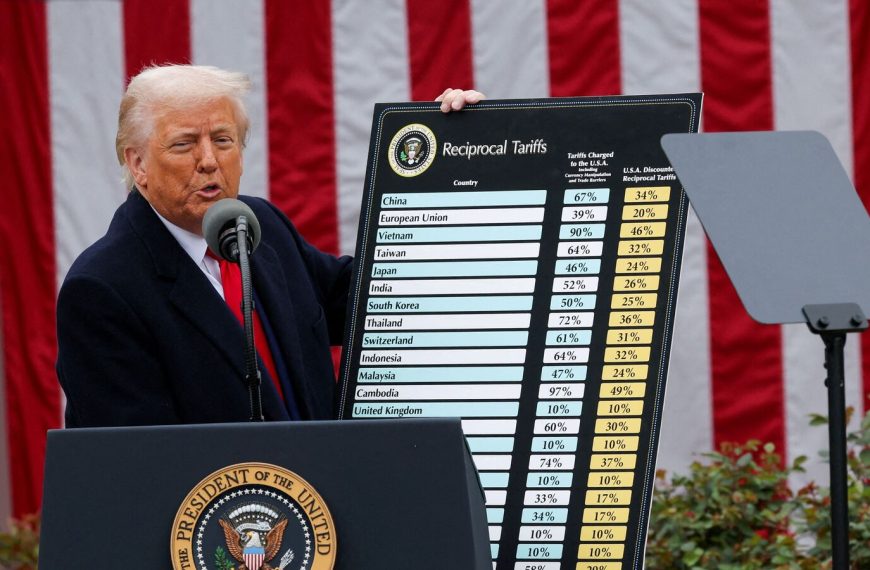Treasury yields are on the rise following a prolonged drop, as traders assess the likelihood of adjustments in Federal Reserve policies. Meanwhile, Asian stock markets showed a slight decline as investors navigated the uncertainties surrounding President Donald Trump’s impending announcement of broad tariffs. With significant indexes in Japan and South Korea dipping early in the trading session, the atmosphere remains tense as the deadline approaches.
Trump’s Tariff Announcement Looms
The anticipation surrounding Trump’s plans for reciprocal tariffs has reached a critical point, with reports indicating that his administration is finalizing the details of these new trade measures. The unpredictability of these tariffs has rattled financial markets, leading economists to revise growth forecasts downwards while central bankers are increasingly concerned about the inflationary repercussions of rising import costs.
- Effective Date: The tariffs are expected to take effect immediately after their announcement, which is scheduled for 4 p.m. New York time on Wednesday.
- Market Sentiment: “Investor sentiment remains fragile ahead of tariff day,” noted Fawad Razaqzada from City Index and Forex.com. He emphasized the cautious tone among investors due to the unclear specifics of the tariffs.
A Historic Trade Move
Trump’s forthcoming tariffs, dubbed "Liberation Day," are anticipated to encompass a broader range of trade than the historical Smoot-Hawley tariffs of 1930, which serve as a warning against the dangers of protectionism. This initiative is part of Trump’s broader strategy to reshape the global trade landscape, which he argues has not benefitted American interests.
- HSBC Insights: Strategists at HSBC, led by Max Kettner, expressed skepticism about the clarity following “Liberation Day.” They suggested that the April 2 deadline might introduce even more uncertainty, potentially leading to ongoing weak performance in key economic indicators.
Market Reactions and Shifts
On Tuesday, the S&P 500 saw a modest increase of 0.4%. Notably, the "Magnificent Seven" tech giants halted a four-day selling spree, with Tesla Inc. surging 3.6% ahead of its quarterly sales report. Meanwhile, the yield on 10-year Treasuries fell by four basis points to 4.17%, while the dollar remained stable and gold traded close to record highs.
Despite a shift in outlook, three prominent Wall Street firms—Goldman Sachs, Societe Generale, and Yardeni Research—conceded that their previous estimates for the S&P 500 were overly optimistic, lowering their year-end projections while still expecting a rise from Monday’s close.
Treasuries’ Attractive Performance
Market analysts anticipate a continued strong performance for Treasuries, particularly as indicators of cooling U.S. growth have sparked a rally that has pushed benchmark 10-year yields down nearly half a percentage point since January. Following a trend, hedge funds have shifted their positions to favor U.S. Treasuries over equities, a rotation supported by Barclays Plc analysis.
- Recession Risks: With rising recession fears, Pacific Investment Management Co. highlights the appeal of "stable sources of returns" in global bonds, cautioning that Trump’s aggressive trade and immigration policies could slow economic growth more than previously predicted.
Key Market Movements
Here are some notable market shifts:
-
Stocks:
- S&P 500 futures: Steady
- Hang Seng futures: Down 0.4%
- Japan’s Topix: Down 0.5%
- Australia’s S&P/ASX 200: Up 0.2%
- Euro Stoxx 50 futures: Up 1.4%
-
Currencies:
- Euro: Stable at $1.0791
- Japanese Yen: Down 0.1% at 149.78 per dollar
- Offshore Yuan: Stable at 7.2802 per dollar
-
Cryptocurrencies:
- Bitcoin: Slight dip to $85,120.89
- Ether: Down 0.6% to $1,901.97
-
Bonds:
- 10-year Treasuries: Yield rose two basis points to 4.19%
- Australia’s 10-year yield: Stable at 4.41%
- Commodities:
- West Texas Intermediate crude: Unchanged
- Spot gold: Unchanged
As the markets brace for the repercussions of Trump’s tariff announcements, investors remain vigilant about the evolving landscape of global trade and its implications for economic stability.











